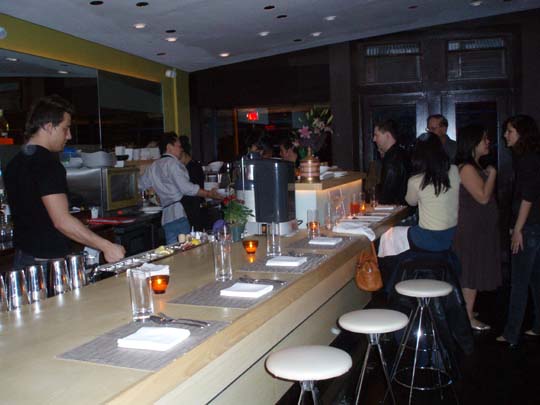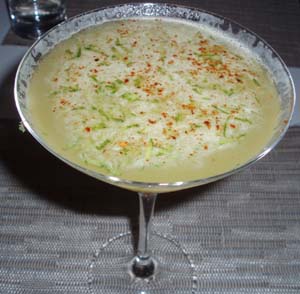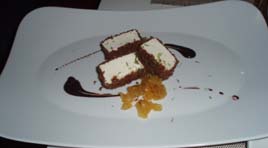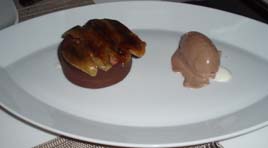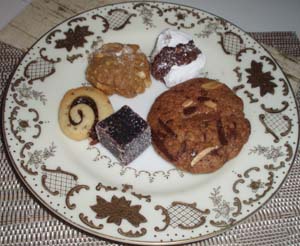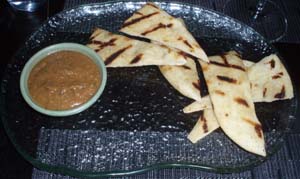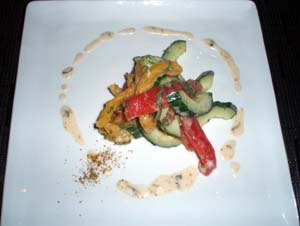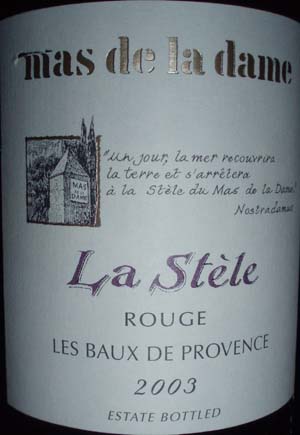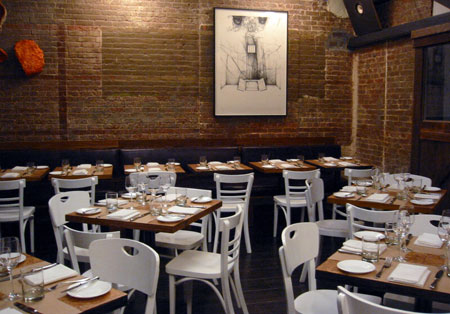
Note: Click here for a review of the Tasting Room’s hamburger and the 2008 menu changes. As of June 2008, the Tasting Room has closed. The restaurant Jo’s replaced it.
The Tasting Room opened in 2000 in the East Village, and was an immediate hit. Those were the days when the East Village hadn’t quite “arrived” as a dining destination. But diners flocked to the Tasting Room anyway. William Grimes of the Times wasn’t quite as impressed, awarding just one star.
Chef Colin Alevras and his wife Renée eventually outgrew the 11-table space, and last year they moved to NoLIta, tripling the size of the restaurant. (The old space is now the Tasting Room Wine Bar and Café.) Was the move an improvement? Adam Platt of New York says yes, awarding two stars. Frank Bruni of the Times says no, awarding just one.
Bruni endured sub-par service, but the early hiccups have now been worked out. We had a thoroughly enjoyable experience at the Tasting Room last Saturday night. Alevras may not hit a home run with every dish, but most of what he does is first-class, and the service team is on top of their game.
The menu’s main conceit—from which the restaurant draws its name—is that each dish is available in two portion sizes: “taste” and “share.” These basically correspond to appetizer and entrée portions. The menu is divided into two sections on facing pages—“To Start” and “To Continue”—and you can have either a taste or a share of any item, on either side.
Got that? It gets more confusing still. Although the larger portions are labeled “To Share,” the server recommended ordering five or six “Tastes,” and sharing those. So, it turns out that the “Tastes” can be shared, too. If you longed for a simpler ordering system, you would be entirely justified.
On the starter side of the menu, tastes are $11–16, shares are $18–28. On the entrée side of the menu, tastes are $16–25, shares are $28–46. The most expensive share is not what you’d expect: it’s a serving of Morel & Porcini Mushrooms. The menu changes daily, according to market availability. There were many items that appealed to us, but we finally settled on five “tastes,” to share.
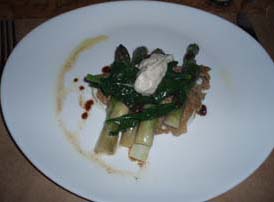

Asparagus (left); Guinea Hen Terrine (right)
The Tasting Room’s creations tend to have a lot of ingredients. Asparagus ($14) came with spinach, crushed eggs, and a buckwheat crèpe. A Guinea Hen Terrine ($14) came with wildflower pollen mustard, a toasted English muffin, onion, and pickled beans. The asparagus was just fine, though I didn’t think the buckwheat crèpe added anything. The terrine was wonderful, but we had never seen such red poultry, and we wondered if it were a mistake. The server assured us it was not. Once again, the English muffin didn’t add much.
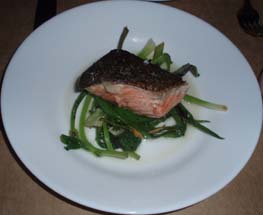

Alaskan King Salmon (left); Lamb Meatballs (right)
Since we had ordered five savory courses, one of them had to come by itself, and that was the Alaskan King Salmon ($22). The menu announced a bunch of accompaniments (chicory, comfrey, green onion, fava bean leaves, sorrel), but they could have been potato chips for all we cared. The salmon ruled here, and it was as tender as you could ever wish for. This was the one must-have dish that we tried.
Lamb Meatballs ($17) came with another cavalcade of supporting actors: shiitake mushrooms, tatsoi, spring onion, grits. Notwithstanding all that, the meatballs seemed like a dish you could make at home—not bad by any means, but not that special either.
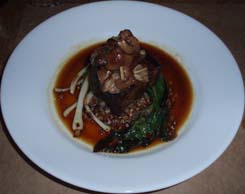
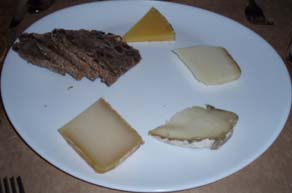
Ossabow Island Pork Belly “under Glass” (left); Selection of American Farmhouse Cheeses (right)
Curiously, the Pork Belly ($18) was the one menu item only offered in the smaller-sized portion. It came to the table with a glass “bell” over the plate, which the server removed in a “Voila” moment. As usual, the pork came with plenty of friends (mushrooms, buckwheat, ramps), but it didn’t need all that help. It was a luscious serving, rich in fat and bountiful in flavor.
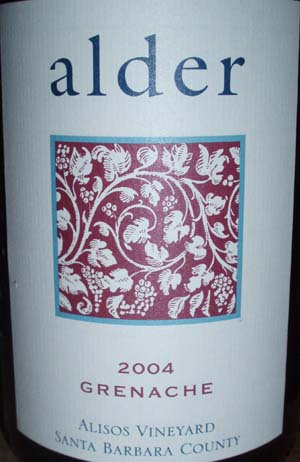 We concluded with the cheese plate ($15) with walnut raisin bread, which was just fine, but didn’t have the smooth-to-sharp progression of the better cheese selections we’ve had.
We concluded with the cheese plate ($15) with walnut raisin bread, which was just fine, but didn’t have the smooth-to-sharp progression of the better cheese selections we’ve had.
Even in its original location, the Tasting Room was known for its selection of American wines, many from obscure producers. The present list is still mainly American, but there are ample selections from France and a few other places.
Given the restaurant’s emphasis on locally-sourced ingredients, we wondered why there weren’t more Long Island wines on the list. But it was not an evening to solve that mystery, so we turned to California: Alder Grenache 2004, Alisos Vinyard, Santa Barbara County ($48), which went well with the rest of our order.
I left with the sense that many of the dishes could do with one or two fewer ingredients, but Alevras has a sure-handed touch with poultry, fish, and meats. Out of our six choices, not one was disappointing. The King Salmon and the Pork Belly were especially impressive.
The décor is a kind of “barnyard chic” that’s appropriate for the neighborhood. We had a 6:30 p.m. reservation, and the space didn’t really start to heat up until we were about ready to leave. We didn’t find it overly noisy. Service was knowledgeable and attentive.
I can’t make comparisons to the old Tasting Room, which I never visited, but the current version seems to have its act together.
The Tasting Room (264 Elizabeth Street, south of Houston Street, NoLIta)
Food: **
Service: **
Ambiance: **
Overall: **
 Wednesday, May 23, 2007 at 07:15AM
Wednesday, May 23, 2007 at 07:15AM  Christian Pappanicholas,
Christian Pappanicholas,  Resto,
Resto,  Ryan Skeen in
Ryan Skeen in  BruniBetting
BruniBetting 









